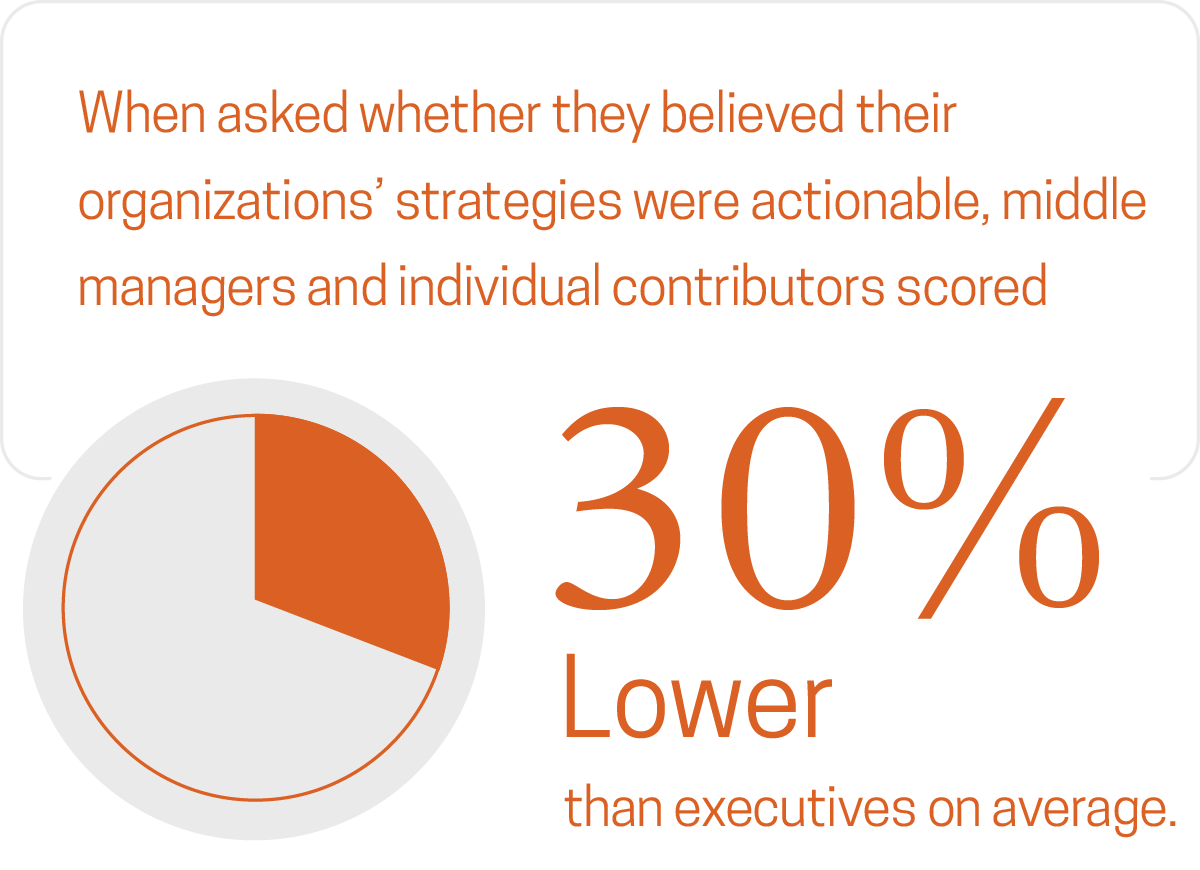Whether your organization is implementing a new hybrid workplace model, merging with another company, or executing a new growth strategy, change management is critical to successful organizational transformation. When leading organizations through major changes, leaders often focus on communicating the vision and the benefits of the end state. However, there are many additional risks to a comprehensive change management plan that should be considered.
We have worked with hundreds of clients to both help identify the risks and craft a strategy to address them – to arrive at the organization’s new end state, faster. From our experience, here are the most common barriers to transformational change.
1. Lack of an Enduring, Goal-Focused Communication Strategy
When asked whether they believed their organizations’ strategies were actionable, middle managers and individual contributors scored 30% lower than executives on average. The key driver of this gap is efficacy of organizational communications. While leaders know the importance of communicating change, they frequently overestimate the impact of their efforts.
When it comes to your communication strategy, an organization-wide email and pre-recorded message can’t be your only change management communications. A recent study on email rates showed that only 40% of employees will read more than 30% of any given internal e-mail. Simply increasing the frequency of communications can actually further desensitize employees and thus doesn’t provide a solution.
Another important factor in driving buy-in and engagement to organizational strategy changes is ensuring individual teams understand how their goals contribute to overall organizational success. Leaders must communicate organizational strategy in a way that helps teams tie their goals to organizational outcomes, while leaning on managers and network influencers to reinforce those messages as well.


Figure 1. When asked whether they believed their organizations’ strategies were actionable, middle managers and individual contributors scored 30% lower than executives on average.
Figure 2. A recent study on email rates showed that only 40% of employees will read more than 30% of any given internal email.
2. Inadvertently Excluding Network Influencers
Ensuring that your organization's leaders are aligned and bought into the organizational change is critical to successful change management – but what about informal leaders not listed on your organizational chart? Network influencers can be found at all levels of an organization and frequently fly under the radar of executive leadership in large organizations. Given that network influencers frequently act as information brokers and influence how others perceive the organization, they should be identified and carefully considered in your change management efforts.
In one study with a client undergoing a recent merger, McChrystal Team Science uncovered that a few individuals were responsible for brokering connections between two major teams. While management had spent time and energy focusing on the financial success of the acquisition and the subsequent strategy changes, they had failed to consider the operational influencers. The risk of losing or alienating those key influencers in sales and product development jeopardized the success of the new product strategy.
Identifying key influencers and collaborators to determine who should be prioritized for in-office return can also help drive productivity and ramp up your organizations post-COVID hybrid environment.
Once you have identified your network influencers by conducting an organizational network analysis, you can incorporate them into your change management strategy by creating a liaison network, a change champion network, and by reaching out to them for bottom-up feedback. By incorporating their feedback early on, your organization can reap the benefit of fine-tuning the tactical execution while also building buy-in and credibility for the efforts.
3. Failing to Establish and Clarify New Team Boundaries
Failing to establish new working relationships, ownership, and cultural norms often presents one of the largest sources of frustration in organizational change. While leadership focuses on the end state of a new strategy, the initiatives that underpin that strategy frequently have unforeseen and inadvertent impacts. Depending on the nature of the transformation, teams can experience massive changes in processes and working relationships that are difficult to predict and coordinate. From a risk perspective, changed lines of communication and expectations create an environment where mistakes can be made due to lack of coordination. Over the long term, poor coordination can lead to frustration, damaged relationships, and ultimately mistrust in leadership.
In our research across all clients, 36% of respondents, including individual contributors, middle managers, and executives, believe that leadership has adequately defined roles and responsibilities across teams. Additionally, only 43% of respondents believe that teams collaborate in a way that contributes to organizational success. Given that collaboration and clear roles and responsibility are such a challenge for all large organizations, leaders need to take additional precautions when leading their teams through change. To prevent your organization from being blind-sided by operational risks and missed handoffs, consider running a decision space exercise or a red team exercise with subject matter experts and leaders in the divisions undergoing change.
4. Not Collecting Bottom-Up Feedback
In all large organizations, frontline employees have valuable insights that are frequently overlooked. During times of transformational change, your frontline can serve as real-time resources and feedback mechanisms to monitor the progress of your new initiatives or efforts. However, many organizations lack the capability to provide frontline employees with a way of escalating and providing insights to leadership. To make matters worse, senior leaders often overestimate their organization’s ability to integrate feedback: according to our research, 59% of VPs and above believe their company’s leadership is receptive to new ways of doing business, while only 46% of frontline employees feel the same. From a risk perspective, failing to consider your frontline potentially slows down your reaction time to challenges such as new competitors and threats and overestimating your company’s ability lulls you into a false of security. In the long term, the risk is that your people will lose trust in leadership. Organizations with low trust in leadership frequently experience lower productivity, low psychological safety, high-turnover, and stifled innovation.
While these four risks are the most common barriers to organizational transformations that Team Science has seen, the challenges you will encounter will be unique to your organization. An organization undergoing transformation, by definition, changes over time – being vigilant in monitoring risk should go hand-in-hand.



